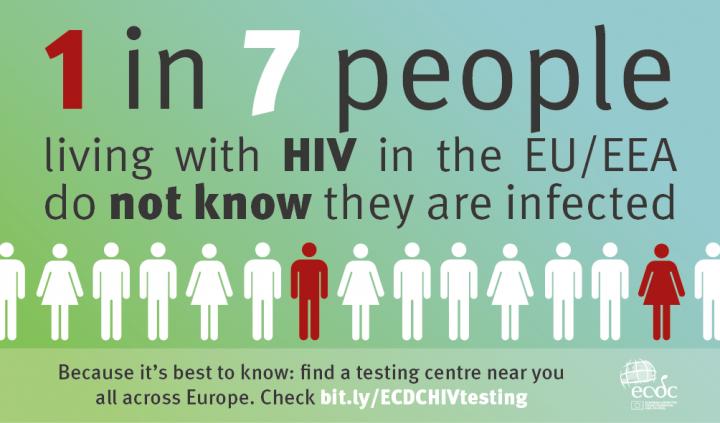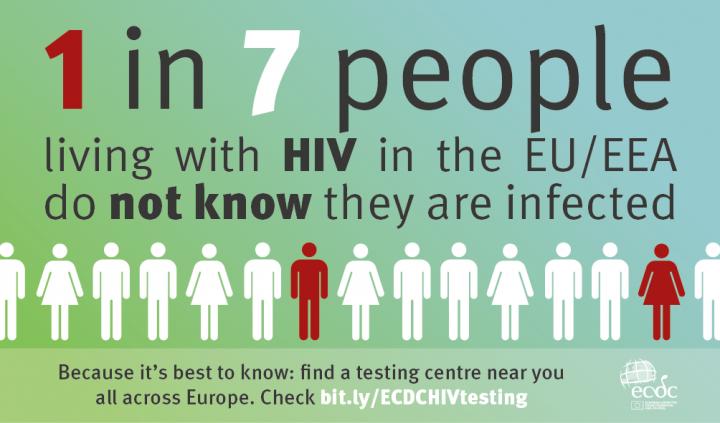
Credit: European Centre for Disease Prevention and Control, ECDC.
With 29 747 newly reported HIV infections in 2015, the EU/EEA notification rate is similar to recent years with an overall insignificant change from 6.6 per 100 000 population in 2006 to 6.3 in 2015 (adjusted for reporting delay).
European Commissioner for Health and Food Safety, Vytenis Andriukaitis, said: "HIV/AIDS continues to be a serious problem in Europe. The Commission is committed to helping Member States reach the SDG target of ending HIV/AIDS and Tuberculosis by 2030 and reducing Hepatitis, as underlined a few days ago in our Communication for a sustainable European future. ECDC's estimate that one in seven people living with HIV are unaware of their status is particularly worrying: people who do not know they are infected cannot benefit from life-saving treatment, and can continue to transmit the virus to others. This is why easy and accessible testing is so important. The European Commission supports HIV testing by working together with Member States and civil society on joint projects, funded by the EU Health Programme, on prevention and linkage to care."
"The facts we know about the HIV epidemic in the EU/EEA, are based on the number of new diagnoses reported each year, which represents the cornerstone of European HIV surveillance", explains ECDC Acting Director Andrea Ammon. "But we also know that these figures do not reflect the true picture. ECDC estimates that currently around 122 000 people in the EU/EEA are infected with HIV but are not aware of their infection – that is every 1 in 7 people living with HIV in the region."
If diagnosed and treated early enough, people can live long and healthy lives with HIV. "To reach the estimated 15% who are not aware of their infection, we need to increase efforts to promote and facilitate more testing for HIV. And link those diagnosed to care. A simple and quick blood test allows people to determine their HIV status. It's best to know your HIV status so you can take care of your own health – and also protect others", stresses Ammon. "ECDC is currently supporting Member States to standardise and improve their national estimates regarding the number of people living with HIV. This should lead to a more effective HIV response, because it enables better targeting of resources at the populations they identify as being most at risk in that country."
"Despite significant efforts, HIV remains among the main public health concerns in the WHO European Region, in particular in its eastern part. 2015 recorded the highest number of new cases in one year, contributing to an appalling 2 million cumulative cases", says Zsuzsanna Jakab, WHO Regional Director for Europe. "To address this critical situation, we have made available a new action plan that all European countries endorsed in September 2016. We now call on countries' leaders to use this plan for an urgent, accelerated and innovative response to HIV in the Region, to reverse the AIDS epidemics immediately and end it by 2030".
In the EU/EEA, sex between men is still is the main reported HIV transmission mode, accounting for 42% of all notified HIV diagnoses in 2015 and for more than half of new diagnoses in 15 countries . Men who have sex with men are the only group in the EU/EEA that has seen a steady increase in notifications over the years. With 32% of reported HIV diagnoses, sex between women and men is the second most commonly reported mode of transmission in the EU/EEA, followed by injecting drug use (4%).
Time between infection and diagnosis in the EU/EEA: four years
The new surveillance data also show that almost every second (47%) HIV positive person in the EU/EEA is diagnosed at a late stage of infection. The new ECDC estimate revealed that, on average, it takes almost four years (3.8) before an HIV infection is diagnosed and reported. This again suggests persistent problems with access to, and uptake of, HIV testing in many countries.
The European Test Finder makes it easy to locate an HIV testing site in Europe: all that is needed is a post code or city name to find the nearest test centre. This year's updated version also includes places for STI and hepatitis testing. In addition, available ECDC Guidance and results from monitoring the Dublin Declaration on Partnership to Fight HIV/AIDS in Europe and Central Asia assist Member States in their HIV response.
Read the full report HIV/AIDS surveillance in Europe 2015
###
Notes to editors:
The ECDC HIV estimate: The estimate for the EU/EEA countries is based on a modelling exercise with existing HIV and AIDS surveillance data for the years 2003 to 2015 data using the ECDC HIV modelling tool. Data on the estimated number of people living with HIV in 2014-2015 were reported by nominated contact points in EU/EEA countries to ECDC as part of the Dublin Declaration monitoring process. Based on country reports, the estimated total number of people living with HIV in the EU/EEA is around 810 000 (0.2% adult population). The resulting estimated proportion of those living with undiagnosed HIV is 15%. National estimates and those within certain populations at highest risk of HIV are likely to vary widely across countries
The WHO European Region comprises 53 countries, with a population of nearly 900 million people, of which around 508 million live in the EU/EEA (28 EU Member States plus Iceland, Liechtenstein and Norway). In 2015, 153 407 new HIV diagnoses were reported from 50 of the 53 countries, resulting in a rate of 17.6 per 100 000.
World AIDS Day was introduced by the World Health Organization (WHO) in 1988 and is observed annually on 1 December to raise awareness of the AIDS pandemic caused by HIV infection.
Media Contact
ECDC Press Office
[email protected]
46-858-601-678
@ECDC_EU
http://ecdc.europa.eu
############
Story Source: Materials provided by Scienmag




